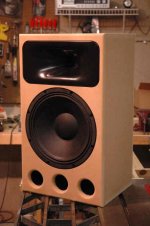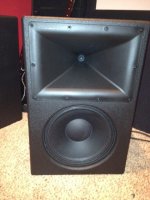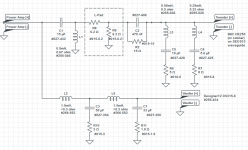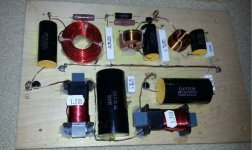1. Sure, the crossover is designed to work with nominally 8 Ohm drivers. However, driver impedance ratings (Ohm) are nominal, as in reality the impedance is dependent on frequency. A nominal 8 Ohm driver may have different impedances at different frequencies ranging from 5 Ohm to 150 Ohm. The chance of it being 8 Ohm at the crossover frequency is very low. If it is not 8 Ohm at the frequency, the crossover will not function correctly.
2. A textbook crossover (like the one proposed) assumes that all drivers are at the same point in space. Of course, this can never be the case, and distances between drivers - especially differences in the distance from the driver's acoustic centres to the listener - impact massively on the function of the crossover, especially at higher frequencies (i.e. midrange to tweeter). So again, the chances of an off-the-shelf crossover functioning anything like correctly for you are extremely low.
You provide valid information andreasmaaan, but have you considered the age and experience of your audience?
See post 55.
OK, so if you want to learn, you should take this 1 step at a time. The 1st thing you want to do is set your design parameters for your woofers. These should be:
1. price - up to you
2. F3 - which is the point at which the FR (frequency response) drops 3dB below the fundamental (not half as loud as previously stated); minimum for music should be 40Hz, closer to 30Hz would be better.
3. maximum SPL - you want it loud (god help your ears ) so minimum should probably be 105dB at 1 meter, 110dB would be better, before xmax is exceeded at about 25-30Hz. Xmax is the distance the voice coil can travel in 1 direction while staying within the magnetic gap. Maximum mechanical travel is almost always larger than xmax. And you must also be sure the watts required for the max SPL is within the driver's max power rating. And within the capability of your amp.
) so minimum should probably be 105dB at 1 meter, 110dB would be better, before xmax is exceeded at about 25-30Hz. Xmax is the distance the voice coil can travel in 1 direction while staying within the magnetic gap. Maximum mechanical travel is almost always larger than xmax. And you must also be sure the watts required for the max SPL is within the driver's max power rating. And within the capability of your amp.
4. maximum box size - you decide how large you want them to be. Calculate the volume. Now find the driver(s) that fit.
5. minimum impedance - you don't need an 8ohm load if your amp is built to handle 4ohm speakers. Most amps can do so easily.
6. For an easier xo, selecting a smoother FR is helpful too.
Now download a free box modeling program. I prefer Unibox but you need Excel. WinISD Pro will do otherwise. Now start simulating drivers until you find the ones that suit your design goals.
This is how you start to design speakers. Also, when you set up the proper design criteria, it's much easier for other people to help you as well.
To help you understand this process, here are 3 examples with graphs below:
Eminence Delta-12B 12" wants about 130L for F3 of 42Hz giving you 104dB with 5W before xmax is exceeded with content above about 35Hz. Graphs 1 & 2.
Dayton DC250-8 10" wants about 50L for F3 of 32Hz giving you 102dB with 30W before xmax is exceeded with content above about 22Hz. Two in parallel will need twice the box volume and give 108dB max with everything else the same. 4ohm on the amp instead of 8ohm. Graphs 3 & 4.
And just to show you that size isn't the only parameter that matters for a driver's LF (low frequency) extension, here is what a monster 6.5" driver can do (Exodus Anarchy for the curious): it wants about 30L for an F3 of 30Hz giving you 100dB with 45W before xmax is exceeded at all musical frequencies. Graphs 5 & 6.
Now download 1 of the programs and get started.
1. price - up to you
2. F3 - which is the point at which the FR (frequency response) drops 3dB below the fundamental (not half as loud as previously stated); minimum for music should be 40Hz, closer to 30Hz would be better.
3. maximum SPL - you want it loud (god help your ears
4. maximum box size - you decide how large you want them to be. Calculate the volume. Now find the driver(s) that fit.
5. minimum impedance - you don't need an 8ohm load if your amp is built to handle 4ohm speakers. Most amps can do so easily.
6. For an easier xo, selecting a smoother FR is helpful too.
Now download a free box modeling program. I prefer Unibox but you need Excel. WinISD Pro will do otherwise. Now start simulating drivers until you find the ones that suit your design goals.
This is how you start to design speakers. Also, when you set up the proper design criteria, it's much easier for other people to help you as well.
To help you understand this process, here are 3 examples with graphs below:
Eminence Delta-12B 12" wants about 130L for F3 of 42Hz giving you 104dB with 5W before xmax is exceeded with content above about 35Hz. Graphs 1 & 2.
Dayton DC250-8 10" wants about 50L for F3 of 32Hz giving you 102dB with 30W before xmax is exceeded with content above about 22Hz. Two in parallel will need twice the box volume and give 108dB max with everything else the same. 4ohm on the amp instead of 8ohm. Graphs 3 & 4.
And just to show you that size isn't the only parameter that matters for a driver's LF (low frequency) extension, here is what a monster 6.5" driver can do (Exodus Anarchy for the curious): it wants about 30L for an F3 of 30Hz giving you 100dB with 45W before xmax is exceeded at all musical frequencies. Graphs 5 & 6.
Now download 1 of the programs and get started.
Attachments
-
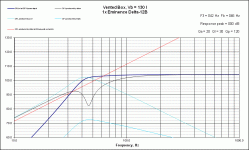 VB FR Eminence Delta-12B.gif28 KB · Views: 101
VB FR Eminence Delta-12B.gif28 KB · Views: 101 -
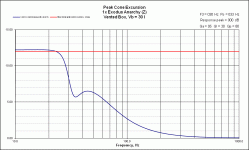 VB Excursion Exodus Anarchy (Z).gif20.8 KB · Views: 24
VB Excursion Exodus Anarchy (Z).gif20.8 KB · Views: 24 -
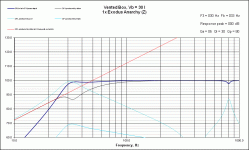 VB FR Exodus Anarchy (Z).gif29.7 KB · Views: 89
VB FR Exodus Anarchy (Z).gif29.7 KB · Views: 89 -
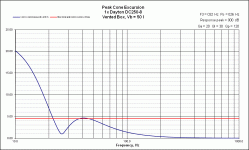 VB Excursion Dayton DC250-8.gif21.7 KB · Views: 90
VB Excursion Dayton DC250-8.gif21.7 KB · Views: 90 -
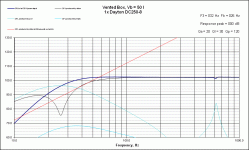 VB FR Dayton DC250-8.gif27.9 KB · Views: 97
VB FR Dayton DC250-8.gif27.9 KB · Views: 97 -
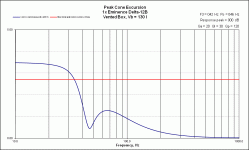 VB Excursion Eminence Delta-12B.gif19.8 KB · Views: 95
VB Excursion Eminence Delta-12B.gif19.8 KB · Views: 95
OK, so if you want to learn, you should take this 1 step at a time. The 1st thing you want to do is set your design parameters for your woofers. These should be:
1. price - up to you
2. F3 - which is the point at which the FR (frequency response) drops 3dB below the fundamental (not half as loud as previously stated); minimum for music should be 40Hz, closer to 30Hz would be better.
3. maximum SPL - you want it loud (god help your ears) so minimum should probably be 105dB at 1 meter, 110dB would be better, before xmax is exceeded at about 25-30Hz. Xmax is the distance the voice coil can travel in 1 direction while staying within the magnetic gap. Maximum mechanical travel is almost always larger than xmax. And you must also be sure the watts required for the max SPL is within the driver's max power rating. And within the capability of your amp.
4. maximum box size - you decide how large you want them to be. Calculate the volume. Now find the driver(s) that fit.
5. minimum impedance - you don't need an 8ohm load if your amp is built to handle 4ohm speakers. Most amps can do so easily.
6. For an easier xo, selecting a smoother FR is helpful too.
Now download a free box modeling program. I prefer Unibox but you need Excel. WinISD Pro will do otherwise. Now start simulating drivers until you find the ones that suit your design goals.
This is how you start to design speakers. Also, when you set up the proper design criteria, it's much easier for other people to help you as well.
To help you understand this process, here are 3 examples with graphs below:
Eminence Delta-12B 12" wants about 130L for F3 of 42Hz giving you 104dB with 5W before xmax is exceeded with content above about 35Hz. Graphs 1 & 2.
Dayton DC250-8 10" wants about 50L for F3 of 32Hz giving you 102dB with 30W before xmax is exceeded with content above about 22Hz. Two in parallel will need twice the box volume and give 108dB max with everything else the same. 4ohm on the amp instead of 8ohm. Graphs 3 & 4.
And just to show you that size isn't the only parameter that matters for a driver's LF (low frequency) extension, here is what a monster 6.5" driver can do (Exodus Anarchy for the curious): it wants about 30L for an F3 of 30Hz giving you 100dB with 45W before xmax is exceeded at all musical frequencies. Graphs 5 & 6.
Now download 1 of the programs and get started.
Ok this is very confusing to me but I have like 2 months until I build my box so I will need to re-read this about a million times.
You provide valid information andreasmaaan, but have you considered the age and experience of your audience?
See post 55.
I know I'm only 14 but that doesn't make me any less capable of learning this stuff and building a crossover. Sure I don't want to but if it is necessary to build one to have decent sound then I will do it.
If you were speaking to a 25 yr old with the same experience I had, they are not any more likely to understand the terminology or learn this stuff better.
If you were speaking to a 25 yr old with the same experience I had, they are not any more likely to understand the terminology or learn this stuff better.
That's so true WillHoog!
It wasn't my intention to underestimate your abilities. You have already proved to me that you are intelligent and articulate.
I was merely applying the learning to walk before learning to run principle.
Sorry if I have given the wrong impression and apologies also to andreasmaaan for interfering!
Last edited:
Ok this is very confusing to me but I have like 2 months until I build my box so I will need to re-read this about a million times.
That's fine. Ask questions where you need to.
But I strongly recommend that you do not build any boxes or buy any drivers until you master these basics. Because if it's not apparent from my post above, the Eminence would not be the best driver for your purposes. Two of the Dayton 10" woofers are going to go lower, play louder at those LF's, do it in much smaller boxes and cost you a lot less money.
I'm going to eat some lunch rn so i can't look into it too much yet but is it possible to get 12" dayton drivers that do the same? I would be willing to apend a couple extra dollars on that but if it isn't possible then 10" are fine, just that my 8" ones clip at extreme volume and 2" might not make the biggest difference...
Again I'm not building boxes for maybe 2 months giving me plenty of time to master these concepts. I have already learned so much in 3 days!
btw how do I change my username, my first name is just Will
Again I'm not building boxes for maybe 2 months giving me plenty of time to master these concepts. I have already learned so much in 3 days!
btw how do I change my username, my first name is just Will
Last edited:
I plan on building a pair of large 3 way speakers with 12" drivers. - For each speaker I plan on having 2 12" inch woofers on the bottom, right above those 1 12" mid range driver, and above that a tweeter.
Test equipment and crossover components are expensive. If you purchase proven quality drivers with a proven crossover you will be able to construct a good speaker even without measurements or crossover experiments.
The 12" Dayton DS315(4/8 ohm) paper cone and DSA315(4/8) aluminum cone are low Fs=24Hz woofers($75-$85 PartsExpress). There is a well reviewed modest cost EconoWave for the $38 Dayton DP250 compression driver with the $13 SEOS waveguide, and one DS315_paper woofer, which in a 1.3cuft sealed volume has -F3=60Hz with excellent transient performance.. OR in a 2.2cuft ported volume has -F3=38Hz. The "fully tweeked" crossover circuit is shown, but the RLC notch filters on the tweeter can be removed with modest sonic changes to reduce cost.
Adding two aluminum cone DSA315 woofers in a 4-5cuft ported cabinet will extend the bass to 30Hz. Your 3*12" goal.
You could construct you final large cabinet, and start with just the single 12" EconoWave in the ported box, and add the extra 12" woofers as funds become available. You will have good initial sound quality, and a path to your dream design.
Attachments
Some of the terminology you are using I am not familiar with but with the 2 woofers making the front be 16" by 20" that is 4400/480 which is 9.167. 9.167" seems very short for the width of this loud speaker...
I assume this is directed at me.
Remember that 4,400 cu in is the internal volume.
The internal dimensions of the Fane 2x12" cabinet are in fact 28" x 15" x 10.5" (H x W x D).
Since the cabinet walls are 0.75" thick, the external dimensions will be even bigger.
And this is only a starting point - the mid and tweeter would not fit into this cabinet frontage. The cabinet would either have to be taller or the mid and tweeter could occupy a separate cabinet, to be placed on top of the 2x12" cabinet.
btw how do I change my username, my first name is just Will
No need to change your username.
If you want to be referred to by your first name, then just sign off your posts as Will.
You provide valid information andreasmaaan, but have you considered the age and experience of your audience?
See post 55.
Haha good point Galu, I'd missed the post about Will's age. Still, 15 is plenty old enough to build up the necessary skills so long as you're patient and inquisitive.
And I did advise later in the same post of mine that you quoted to either learn more OR build a kit speaker / proven DIY design
Hi andreasmaaan!
I have already apologised to you and Will for interfering in your post.
Thanks for taking my comment in the spirit in which it was intended!
Will insists he is happy to receive information like yours, so keep it coming!
Thanks! And no problem at all
Test equipment and crossover components are expensive. If you purchase proven quality drivers with a proven crossover you will be able to construct a good speaker even without measurements or crossover experiments.
The 12" Dayton DS315(4/8 ohm) paper cone and DSA315(4/8) aluminum cone are low Fs=24Hz woofers($75-$85 PartsExpress). There is a well reviewed modest cost EconoWave for the $38 Dayton DP250 compression driver with the $13 SEOS waveguide, and one DS315_paper woofer, which in a 1.3cuft sealed volume has -F3=60Hz with excellent transient performance.. OR in a 2.2cuft ported volume has -F3=38Hz. The "fully tweeked" crossover circuit is shown, but the RLC notch filters on the tweeter can be removed with modest sonic changes to reduce cost.
Adding two aluminum cone DSA315 woofers in a 4-5cuft ported cabinet will extend the bass to 30Hz. Your 3*12" goal.
You could construct you final large cabinet, and start with just the single 12" EconoWave in the ported box, and add the extra 12" woofers as funds become available. You will have good initial sound quality, and a path to your dream design.
I am being told to buy a crossover and build one. Which option should I go with to get decent sound? Also I have been told not to have such a big mid so I am going with 8" mid.
I assume this is directed at me.
Remember that 4,400 cu in is the internal volume.
The internal dimensions of the Fane 2x12" cabinet are in fact 28" x 15" x 10.5" (H x W x D).
Since the cabinet walls are 0.75" thick, the external dimensions will be even bigger.
And this is only a starting point - the mid and tweeter would not fit into this cabinet frontage. The cabinet would either have to be taller or the mid and tweeter could occupy a separate cabinet, to be placed on top of the 2x12" cabinet.
I want to keep width and length the same throughout the whole loud speaker so I will adjust the height. Even 10.5" width (or slightly bigger) seems small because what I've seen in speakers, the width is bigger than the length. (That is the length being the side with the drivers)
Test equipment and crossover components are expensive. If you purchase proven quality drivers with a proven crossover you will be able to construct a good speaker even without measurements or crossover experiments.
The 12" Dayton DS315(4/8 ohm) paper cone and DSA315(4/8) aluminum cone are low Fs=24Hz woofers($75-$85 PartsExpress). There is a well reviewed modest cost EconoWave for the $38 Dayton DP250 compression driver with the $13 SEOS waveguide, and one DS315_paper woofer, which in a 1.3cuft sealed volume has -F3=60Hz with excellent transient performance.. OR in a 2.2cuft ported volume has -F3=38Hz. The "fully tweeked" crossover circuit is shown, but the RLC notch filters on the tweeter can be removed with modest sonic changes to reduce cost.
Adding two aluminum cone DSA315 woofers in a 4-5cuft ported cabinet will extend the bass to 30Hz. Your 3*12" goal.
You could construct you final large cabinet, and start with just the single 12" EconoWave in the ported box, and add the extra 12" woofers as funds become available. You will have good initial sound quality, and a path to your dream design.
Those Dayton woofers are subwoofers and I was told I didn't need subwoofers. Also 2 of those in parallel would be 2 ohms meaning I would need to get mids and tweeters that are 2 ohms and a 2 ohm crossover which I don't think is possible
I want to keep width and length the same throughout the whole loud speaker so I will adjust the height.
Hi Will!
Your use of the words 'length' etc. is confusing.
By 'width' I think you mean 'depth' and by 'length' I think you mean 'breadth'.
Your meaning will be clearer if you adopt the following standard terms:
height (H) - meaning from bottom to top (that, at least, we can agree on!)
width (W) - meaning from side to side
depth (D) - meaning from front to back
It would help if you could re-word all of your post.
Last edited:
Can anyone recommend Drivers that can check these points??
I thought we'd got pretty close by looking at the Eminence range!
Have a look at the Alpha series of drivers.
There's almost an infinite number of driver possibilities out there and everyone on this forum has their personal favourites.
We could be here a while, and your birthday is looming closer and closer!
Last edited:
- Status
- This old topic is closed. If you want to reopen this topic, contact a moderator using the "Report Post" button.
- Home
- Loudspeakers
- Multi-Way
- Questions about speaker building
